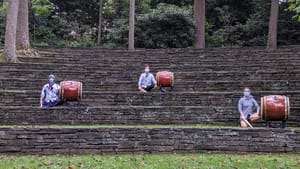Stay in the Loop
BSR publishes on a weekly schedule, with an email newsletter every Wednesday and Thursday morning. There’s no paywall, and subscribing is always free.
Taiko takes Philly
Philly Fringe 2020: Casual Fifth presents ‘Taiko and Dance’

Fringe 2020 is underway, and part-time performance company Casual Fifth Taiko and Dance, created by Alex Pfister and Mac Evans, collaborated with friends and mentors to assemble Taiko and Dance. Among a mostly virtual line-up, this show distinguishes itself by predominantly featuring taiko (literally “drum” in Japanese, but overall encompassing the art of Japanese drumming) and modern dance. Divided into three parts, this 23-minute performance is a blend of thunderous percussion, tranquil choreography, and various musical and theatrical styles fused together to create a compelling, yet disjointed, virtual experience.
The power of drums
I first heard of taiko when I lived in Boston. I would pass a studio that conducted classes, and would stop to observe this unfamiliar performance, mesmerized by the booming, rhythmic patterns of the drumming and powerful, yet fluid, movement. Historically in Japan, taiko was used in military and ceremonial arenas, and eventually evolved into a performance art.
The opening piece of Taiko and Dance, “Miyake,” is taiko derived from the island of Miyake-jima, made famous by the influential taiko troupe Kodo, according to Japan’s Miyake Taiko School. This segment, filmed in Swarthmore College’s primordial-looking outdoor amphitheater, is the most moving of the three parts due to the physical and emotional commitment of the performers (Joe Small, Evans, and Pfister). Shooting each segment of Taiko and Dance in nature adds mysticism, as well as some necessary cohesion, to the program.
Dance break
As someone who had trouble following the directions to “Macarena” at middle-school dances, I have a profound respect for what dancers are able to convey through their movement. The second part of the program, “The Shades,” is a series of modern-dance solos based on Auguste Rodin’s The Three Shades.
This work-in-progress, choreographed by world-renowned dancer, choreographer, and educator Jim May, was a necessary palate cleanser in between the electrifying taiko performances. May, with patient yet deliberate extensions, glides dreamlike along Boxer’s Trail in Fairmount Park. Pfister performs the segment’s second piece, “Remember (Subconscious),” and though the movement is graceful, it lacks intimacy, relying too much on the scenic Boathouse Gazebo in FDR Park.
Seen, heard, and felt
The finale, “Lion Chant,” (performed by Small, Evans, Pfister, and Yoko Nakahash) infuses taiko with Balinese movement and chanting, known as Kecak, and Shihimai, or Japanese Lion Dance. The technical inadequacies of the digital format are evident during this ambitious piece. The shots under the arch could have been framed with more care, and the distinct tones of each drum are lost in shoddy audio. As music is a focal point of this production, a sound designer would have elevated the musicality of these pieces, resulting in more clarity and vigor.
It feels unfair yet unavoidable to compare virtual and in-person performances. Taiko is not only something to be heard and seen, but to be felt reverberating in your body—an experience we just have to imagine for the time being. I commend Casual Fifth for blending art forms, and am grateful for the diversity they added to this year’s line-up. But ultimately, technical limitations and the lack of a narrative through-line result in three compelling pieces that feel disconnected and leave me wanting more.
Image description: Three taiko drummers sit next to their drums, spaced widely on the large stone tiers of an outdoor amphitheater.
What, When, Where
Taiko and Dance. By Casual Fifth Taiko and Dance. Through October 4, 2020, part of the Philadelphia Fringe Festival. Watch it free here.
Sign up for our newsletter
All of the week's new articles, all in one place. Sign up for the free weekly BSR newsletters, and don't miss a conversation.

 Kelly Conrad
Kelly Conrad